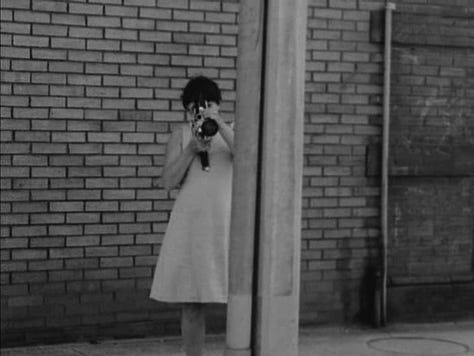◡◶▿ HOME03 | Shootouts with friends
🎥 Good clean fun with a Bolex. Joyce Wieland & Hollis Frampton go hunting. Ito/Deren in New York tomorrow. Watching a video in class. | Renovating the Home Motion Picture Week 3
Hello, dear film students, and welcome to class. First: a deep thank you to those who’ve shared these lessons with their friends and networks. It means a lot for this little film school! For those who are new, please do forward these emails and make use of the share button when it appears.
Before we get on with this week’s case study, a brief look back to last week’s lesson, when we learned how:
A movie’s location and its localness are two very different things.
The Hollywood filmmaker may hide both, but the amateur can never conceal her localness (and that’s great!) -
“The environmental muscle memory of the [amateur] cast and crew writes itself into every gesture and camera move.”
The amateur might embrace her localness as a source of unique techniques, effects, and mistakes.
Missed a week? Joined late? Don’t worry about reading these lessons out of order. Each functions independently. They are sent in a sensible sequence but hardly reliant on it.
Okay. Settle in. In today’s lesson, we will discuss how:
💥 Two titans of the moving image avant-garde made a home action movie together.
🍿 The result is a playful thrill - and a masterclass in both the blockbuster shootout sequence and the giddy home movie.
🫂 Elements of embarrassment, capture, and bold being and doing hark back to our understanding of the home movie as smothering bosom.
🖼️ Our Bolex-wielding heroes rewired their filmmaking muscle memory in a tangled tendril of art and life.
Oh yes, and that home action movie is available to watch at the end. That’s right, teacher’s wheeled the television cart into the classroom.
The home shootout
You can hear me deliver this lesson by scrolling up to the header and clicking Listen and/or the play ▸ button.
The degree to which the shootout is choreographed is not clear. Most likely, they set out to hunt each other, maybe with some pre-set boundaries. Following the rules of the game, not a storyboard or schematic. And then occasionally yelled “vainites” (🤞) and used the temporary truce to plan out a sequence one of them just thought up.
Isn’t that what you would do if you were friends?
One of them is Joyce Wieland. She’s around 37 and will live to be 67. A Canadian painter and New York-dwelling experimental filmmaker.
Her opponent is Hollis Frampton. He is 31. A photographer who started making films five years ago. But who only counts the films that he’s made since 1966. It’s 1967.



The filmmakers attempt to shoot each other with their Bolex cameras. And not get shot. That is the game. Stalking each other around the house and around Toronto. The sound design offers a level of interactivity to a third player: the audience, who plays as witness. Albeit a witness trapped within the weapon.
The sound design is simple but sophisticated. Different combinations of shutter whirr from the two cameras (and a cat) and a mix of live and foleyed naturalistic sounds. The sounds triangulate the audience’s position relative to the two camera operators. The audience locates the alternating enemy in the field of view while re-orienting themselves as witness-accomplice.
The cutting betrays these home moviemakers as dedicated film rhythmists. Wieland’s editing and Frampton’s slapstick timing. As a result, despite the lack of “stakes,”* the shootout remains compelling. The audience must wonder what a Hollywood shootout directed by Wieland and Frampton might look like, although this immediately begs the question, “What is a Hollywood shootout for?”
For the general filmmaking student, A and B in Ontario (1967-84) is an action movie masterclass. A masterclass in genre that foretells tropes that later action movies would adopt. Or an art movie masterclass. Exposing new perspectives on the practice of these respected filmmakers.
But the more particular filmmaking student might stop to ask: isn’t this a home movie? Isn’t that what’s special?
They play, with humbleness and fragile pride.
Frampton’s work tends to be cerebral (if often silly). Here, he thinks with his bones. Wieland’s work tends to be considered (and silly), although she discourages intellectualising it. Here, she considers only years later, editing the footage with her niece. Here, Wieland just does.
“We followed each other around. We enjoyed ourselves,” said Joyce Wieland, according to the YouTube page for A and B in Ontario. “We said we were going to make a film about each other - and we did.”
Both Frampton and Wieland meld art and life in their life and art. His work reflects his life, hers embodies hers. Broadly speaking. In this movie, it is Frampton who embodies and Wieland who reflects. Broadly speaking. In the amateur movie, the environmental muscle memory of the cast and crew writes itself into every gesture and camera move. Here, the muscle memory of the filmmakers’ practice writes itself into their lives.
*There are, of course, stakes. The honour of the game, and the proper use of our limited time on Earth - a theme made visible in a couple of poignant long shots towards the end, and the end title that doesn’t explain why the film was edited 17 years after it was shot, and just months after Frampton’s death at 48.
Please share your thoughts, queries, and exercises from this week’s lesson in the comments.
Teiji Ito Beyond Meshes in New York
If I were in New York tomorrow (Tuesday, 29th October 2024), I should certainly get myself along to Beyond Meshes: the Film Music of Teiji Ito - Presented by Michiko Ogawa. At Anthology Film Archives.
But I’m not! Maybe you are?
Six films scored by or inspired by the mid-20th century composer Teiji Ito, including those he recorded with and for Maya Deren, whose husband he briefly was. (They both died in their 40s; however, Ito was 18 years younger than Deren, and died 21 years later.) (Seems relevant.) All introduced by his biographer, Michiko Ogawa.
Ito’s music is free and irreverent, and unlike anything else. It feels like creativity captured in a bottle, and may be quite addictive to the filmmaker seeking abstract inspiration.
A week of home study
Next week, we’ll take a break for half term. After just three lessons?! “That’s academia!” I’ll be busy seeing castles, miniature towns, and steam trains - and I hope you’ll do the same.
Let me know in the comments!
Class dismissed.
~Graeme Cole.
(Principal)
📹 Unfound Peoples Videotechnic | Cloud-based filmmaking thought. ☁️
🐦 Twitter | ⏰ TikTok | 📸 Instagram | 😐 Facebook | 🎞️ Letterboxd | 🌐 unfound.video







